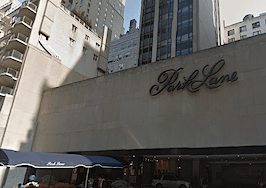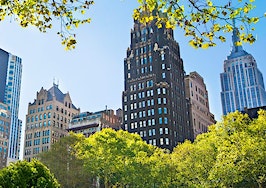- Pelli Clarke Pelli will continue to lead the design, only this time it'll be without the apartments and will feature three additional floors of public spaces.
- Clarke referred to the design as the “right size for smaller startup companies” and the entire development as “a highly-efficient office tower."
- The 98,000 square-foot community center is set to include a café, formal meeting room, fitness center and classrooms. Offices will begin on the 10th floor and continue through the top floor of the tower.
- Aside from the church and parish building, Trinity’s holdings in Manhattan stem from a grant in 1705 from Britain’s Queen Anne, which spanned 215 acres of what was originally farmland.

68-74 Trinity Pl. cirica 2014/Google Maps
In a recent redesign, Trinity Wall Street abandoned plans for a condo development to replace the historic parish office building at 68-74 Trinity Place and are instead pursuing a commercial tower.
Trinity first hired Pelli Clarke Pelli Architects to design its residential tower back in 2013 with plans to include a seven-story office facility for the church, complete with a parish hall. Pelli Clarke Pelli will continue to lead the design of the latest mixed-use office space for the Episcopal parish, only this time it’ll be without the apartments and will feature three additional floors of public spaces.
During its fifth charette, or community meeting with a gathering of civic stakeholders, held on Feb. 20, Trinity referenced a random sample of 10,000 people that confirmed a parallel between the feedback pulled from the charettes and a neighborhood study.
“Frankly, we all felt a bit of a sigh of relief. We were going to do the right thing anyways, but the alignment was really wonderful,” Rev. Dr. William Lupfer, Rector of Trinity Church said during the meeting.
Architect Fred Clarke of Pelli Clarke Pelli remarked on the importance of pulling feedback via charettes.
“Without the charette process… we might have built the wrong building,” Clarke said to community members.
Clarke also gave clues onto the potential tenants of Trinity’s new development. He referred to the design as the “right size for smaller startup companies” and the entire development as “a highly-efficient office tower.”
Rev. Lupfer first hinted at plans to halt residential expansion back in November. However, Trinity did not confirm proposals of the change until recently.
“After listening to input from our many stakeholders, Trinity’s Vestry has determined that a commercial tower above the podium is better suited to supporting the important, mission-focused work that is the basis for the new building. Considering our numerous ministries in Lower Manhattan and our close ties to the community, a flexible office component makes more sense,” Rev. Lupfer said in a prepared statement.
The 98,000 square-foot community center is set to include a café, formal meeting room, fitness center and classrooms. Offices will begin on the 10th floor and continue through the top floor of the tower.
The new Lower Manhattan development will stand across the street from the 170-year-old Episcopal Church. Aside from the church and parish building, Trinity’s holdings in Manhattan stem from a grant in 1705 from Britain’s Queen Anne, which spanned 215 acres of what was originally farmland.
Today, Trinity Wall Street Episcopal Church runs about 5.6 million square feet of commercial property, not including four development sites, according to a 2014 financial report. Last September, Trinity forged a deal with a Norway fund partner for 11 of its office buildings in Hudson Square.









